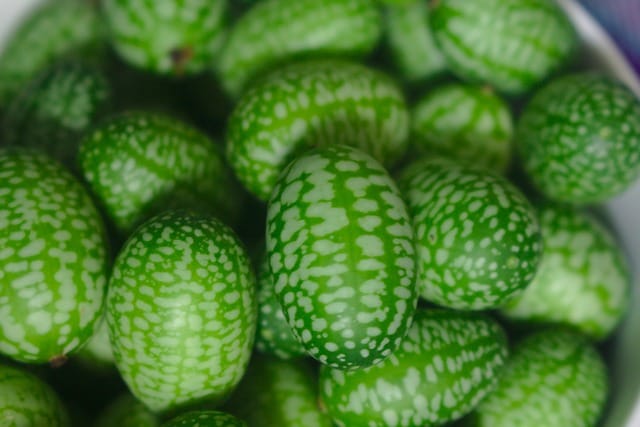How to grow Cucamelons
Welcome to our comprehensive guide on growing cucamelons, a unique and flavorful vegetable that is becoming increasingly popular among home gardeners

In this article:
- Introduction
- What are Cucamelons?
- Choosing the Right Variety
- Climate and Growing Conditions
- Soil Preparation
- Planting Cucamelons
- Watering and Fertilizing
- Trellising or Supporting the Vines
- Pest and Disease Management
- Harvesting Cucamelons
- Storing and Using Cucamelons
- Culinary Uses and Recipes
- Conclusion and Final Tips
Introduction
Welcome to our comprehensive guide on growing cucamelons, a unique and flavorful vegetable that is becoming increasingly popular among home gardeners. In this article, we will cover everything you need to know to successfully cultivate and enjoy these mini cucumbers.
What are Cucamelons?
Cucamelons, also known as Mexican sour gherkins or mouse melons, are small vine-like plants that produce adorable grape-sized fruits resembling tiny watermelons. Despite their appearance, cucamelons are not a hybrid fruit but a different species altogether. They have a delightfully crisp texture and a zesty tangy flavor, making them an excellent addition to salads, cocktails, or pickling recipes.
Choosing the Right Variety
There are several varieties of cucamelons available, each with slightly different characteristics. Some of the popular varieties include:
- Miniature Mexican Sour Gherkins
- Minnesota Midget
- Mexican Sour Gherkin
Climate and Growing Conditions
Cucamelons are native to Mexico and Central America, so they thrive in warm climates. They require full sun exposure to grow and should be protected from strong winds. The ideal temperature range for cucamelons is between 70°F and 85°F. If you live in a cooler region, you can still grow cucamelons by starting the seeds indoors and transplanting the seedlings outside once the soil warms up.
Soil Preparation
Cucamelons prefer well-draining soil rich in organic matter. Before planting, prepare the soil by adding compost or aged manure to improve its fertility and structure. Ensure the pH level of the soil is around 6.0 to 6.8, which is slightly acidic to neutral.
Planting Cucamelons
Plant cucamelon seeds directly in the garden or start them indoors about 6-8 weeks before the last expected frost date. Sow the seeds in small containers, keeping the soil lightly moist until germination. Once the seedlings have developed a few leaves, transplant them outside, allowing 8-12 inches of spacing between plants. Be sure to harden off seedlings before transferring them to the garden to help them acclimate to outdoor conditions.
Watering and Fertilizing
Consistent watering is crucial for cucamelons as they have shallow roots. They prefer moist soil but not waterlogged conditions. Avoid overhead watering to prevent the development of fungal diseases. Apply a balanced organic fertilizer every 4-6 weeks to provide the necessary nutrients for healthy growth.
Trellising or Supporting the Vines
Since cucamelons are vining plants, they require support to grow properly. Install a trellis or provide a sturdy fence for the plants to climb. This helps in maximizing space, reducing disease incidence, and making it easier for harvesting.
Pest and Disease Management
Cucamelons are relatively pest and disease-resistant, making them an ideal choice for organic gardeners. However, they may sometimes face challenges from common garden pests like aphids, slugs, or spider mites. Regularly inspect the plants for any signs of infestation and promptly manage the issue using organic pest control methods.
Harvesting Cucamelons
Cucamelons are ready for harvest approximately 60-70 days after planting. Harvest them when the fruits are about the size of a grape and have a firm texture. Avoid waiting too long, as they can become bitter. Gently twist or cut off the fruits from the vine, being careful not to damage the plant.
Storing and Using Cucamelons
Store freshly harvested cucamelons in the refrigerator, where they can stay fresh for up to two weeks. To use them, simply rinse them in cool water and enjoy them raw or as an ingredient in various dishes.
Culinary Uses and Recipes
Cucamelons can be used in a variety of culinary ways. They make great additions to salads, salsas, or sandwiches, and can also be pickled for a tangy and crunchy snack. Here are a few recipes you can try:
- Cucamelon and Feta Salad
- Cucamelon Salsa
- Refrigerator Pickled Cucamelons
Conclusion and Final Tips
Growing cucamelons can be a rewarding and enjoyable experience. With the right variety, proper care, and attention, you'll soon be harvesting these delightful mini fruits. Remember to save some seeds from your harvest if you want to continue growing cucamelons in the following seasons. Enjoy experimenting with different culinary uses and recipes to fully appreciate the unique flavor of these tiny watermelon-like fruits.
